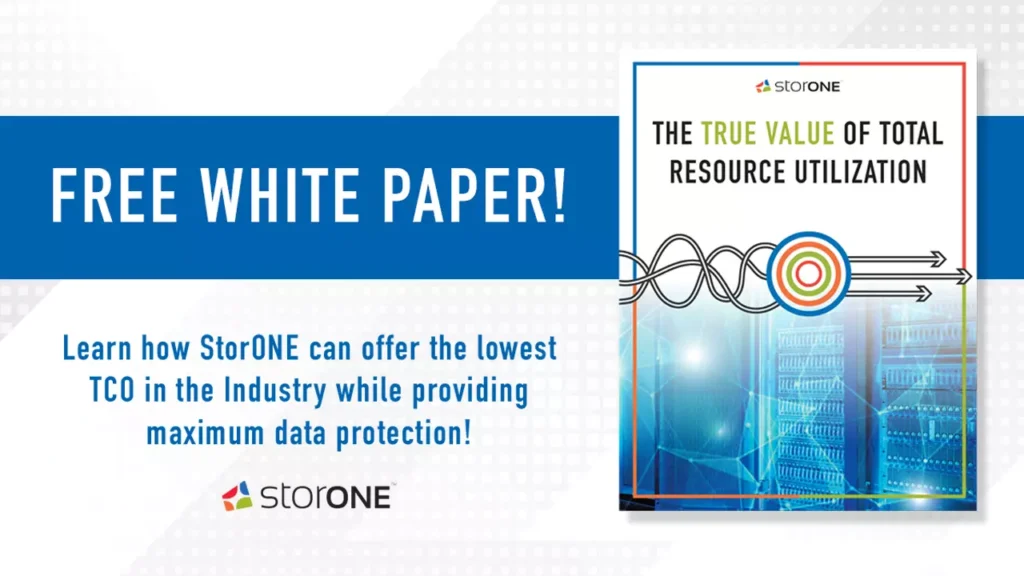Understanding how to calculate storage TCO is critical, especially since the subject seems to have disappeared from most of our competitors’ websites. Storage TCO is the total cost to purchase, operate, protect, and keep current, your storage infrastructure. Since most of our competitors score poorly in each of these categories, it is no wonder they no longer want to discuss it. At StorONE, we are relentless about delivering a minimal TCO with maximum data protection.
Five Steps to Calculating Storage TCO
- Calculate the cost of the entire storage infrastructure
- Calculate the upfront costs
- Calculate operational costs
- Calculate data protection costs
- Calculate storage refresh costs
Step 1: Storage TCO can’t be Siloed
With so many point solutions available on the market today, vendors are forcing customers to think in silos, and they are trying to get you to calculate your TCO in a silo. While it is convenient for them, this is not how you should calculate storage TCO. Your storage TCO is the TOTAL cost of your entire storage infrastructure, not just one silo. Each additional silo adds to the cost of ownership. For example, suppose you select a vendor that has a VMware-specific solution but doesn’t provide file services or bare-metal database support. In that case, you will need to purchase different storage solutions for each of those use cases.
The cloud makes it worse! Vendors force many customers to run an entirely different storage solution in the cloud versus what you run on-premises.
Consolidation, at your pace, is key to minimal TCO. Look for a solution designed to cover all your storage use cases from a single storage solution. StorONE’s Enterprise Storage Platform leverages the efficient StorONE Engine, which flattens the traditional storage IO stack into an efficient layer that can run all of your data center’s storage use cases from a single platform without compromising data protection or performance.
Step 2: Storage TCO Does Include Upfront Cost
Sometimes when IT professionals hear a vendor talk about TCO, they think they are using TCO as a way to justify their high price. Delivering minimal TCO is made easier if you start with a low upfront price. Don’t buy into a vendor’s explanation that their solution will eventually be less expensive than competing solutions.
StorONE’s Enterprise Storage Platform is so efficient that it leverages standard hardware to deliver performance better than competing solutions. Our efficiency also enables us to use 90% of the capacity of the solution without impacting performance. By comparison, our competitors will typically start to see performance flatline at about 50% capacity utilization and degrade significantly at 60% utilization.
When it comes to performance, the Enterprise Storage Platform excels. We can deliver more performance with twelve drives than our competitors can with 48 drives. Assuming an average cost of $4,500 per SSD, that means we will lower the upfront cost by $162,000, just in media! To learn more about our ability to deliver maximum drive performance, check out our white paper “Reducing Storage Costs with Maximum Drive Performance” (no email address required).
Step 3: Storage TCO includes Operational Costs
The time you spend caring for and feeding your storage system also factors into its TCO. Breaking down storage silos, as mentioned in step 1, is one way to lower operational costs. A single storage interface for the data center will lower training costs and improve responsiveness. Beyond that, the storage system has to provide a means not to interrupt your day. An example is what does your storage system require you to do if there is a media failure? Do you need to scramble to insert a new drive or replace a hot spare? Will you be distracted for hours or days, worrying if the rebuild will complete before another drive fails?
With StorONE’s vRAID, rebuilds happen at an industry-leading pace without impacting production performance. We’ve demonstrated complete RAID rebuilds from a high-density hard drive failure in less than 2 hours and flash in less than five minutes. We bring all the volumes back to a protected stated without requiring hot spares or drive replacement. vRAID also helps lower upfront costs. Its rapid RAID rebuilds mean you don’t have to dedicate as much capacity to drive redundancy.
There are countless other steps we’ve taken with our solution to lower operational costs. We recently wrote “Simplifying Storage Provisioning,” which explains how our Application Templates automate provisioning functions.
Step 4 – Data Protection Should be part of Your Storage TCO
Most primary storage systems do a shockingly poor job of protecting themselves, especially given new threats like ransomware. This lack of protection forces IT professionals to implement an entirely different process for data protection, which creates its own TCO equation. You should not separate the cost of data protection from your primary storage TCO. They can’t exist without each other, so they need to be part of the same calculation.
StorONE is obsessed with data protection. Our efficient software foundation enables our cacheless DirectWrite so that all write IO goes to persistent media first and is protected from any RAM or power failure. We’ve discussed StorONE’s vRAID, which protects against media failure, but it also protects against bit rot/silent data corruption.

In addition to vRAID, StorONE’s snapshot technology, S1:Snap, enables us to take a snapshot every minute and retain those snapshots for decades without impacting performance. Most legacy snapshots are limited to a few dozen or maybe one hundred, which is too limited to provide meaningful data protection. Additionally, our snapshots are immutable, protecting them from ransomware attacks.
Finally, there is our replication technology, S1:Replicate, which is independent of snapshots but integrated into our platform. The independence from snapshots means that our replication is continuous and isn’t tied to a snapshot schedule. Replication policies can be set to cascade up to 16 different targets.
The combination of vRAID, S1:Snap, and S1:Replicate, enables an organization to strongly consider replacing backup altogether or, at a minimum, significantly reducing their dependence on it.
Step 5 – The Next Storage Refresh should be part of the Storage TCO
The cost to refresh storage should also be part of your storage TCO. Understand that the cost to move to the next generation of storage hardware and migrating your data to that new platform can be very expensive. Even if the vendor wants to guarantee an upgrade path, those guarantees are an extra cost and almost always require migration.
The StorONE Enterprise Storage Platform is designed to last more than a decade without having to migrate data. If you need to upgrade the controller hardware during that time, those upgrades are seamless and non-disruptive.
Conclusion
The TCO of storage requires calculating many factors that most vendors would prefer you not use in your equation. But you must consider all these factors to get close to understanding the actual cost of your storage infrastructure. Minimizing these factors requires a new approach, one that our Enterprise Storage Platform uniquely delivers. Now that you know how to calculate your storage TCO read our white paper “The True Value of Total Resource Utilization.”





